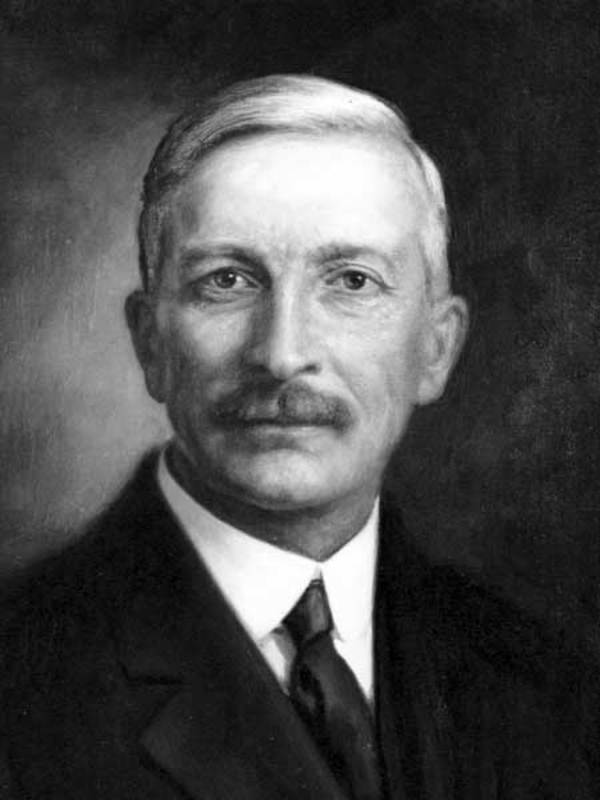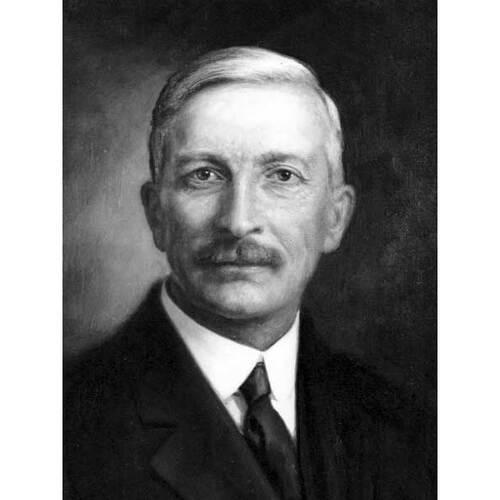
Source: Link
BELL, GORDON, physician, professor, bacteriologist, and sportsman; b. 22 May 1863 in Pembroke, Upper Canada, son of John Bell and Mary Ann Wight; m. 19 Aug. 1897 Grace Campbell McEwan in Elton, Man., and they had a son and a daughter; d. 8 Aug. 1923 in Winnipeg and was buried there in Elmwood Cemetery.
Gordon Bell’s father, a great lover of nature and classical literature, emigrated from Scotland and established a lumber business in Pembroke. His mother was active in their community and the couple kept a large library in their home. In his early years Gordon attended the private school of Mrs Margaret McDougall, an author and poet. He then studied at local public and high schools, where he gained a broad knowledge of mathematics, the sciences, and the classics. He had a shy and reserved disposition, possessed a keen sense of humour, and was sympathetic and generous towards others.
Bell attended the University of Toronto and obtained a ba with distinction in 1886. Hearing of the excellence of the newly formed Manitoba Medical College in Winnipeg, he enrolled in 1887; he would graduate three years later. During his second year at the college, he contacted typhoid fever which caused a severe infection and necessitated the amputation of his right leg in 1889. He was fitted with a wooden leg and limped, but this misfortune did not diminish his spirit or his will to continue his studies. Bell registered with the College of Physicians and Surgeons of Manitoba on 17 June 1891; at the time the annual dues were $2. He would also register with the College of Physicians and Surgeons of the North-West Territories on 3 July 1905 and with the College of Physicians and Surgeons of the Province of Alberta in 1906.
After graduation, Bell had been appointed superintendent and medical officer of the Brandon asylum, a position he held for three years. He resigned to take up graduate studies in Vienna in ophthalmology, pathology, histology, and the new science of bacteriology. After returning to Winnipeg, he practised as a partner with James Wilford Good, the first eye specialist in western Canada, from about 1893 to 1897. During that time he acted as lecturer in histology and pathology at the Manitoba Medical College in 1894 and demonstrator in anatomy there in 1895. He would continue as professor of bacteriology, pathology, and histology from 1896 to 1905, professor of pathology from 1905 to 1916, and professor of bacteriology from 1916 to 1923. A laboratory for his work was built in 1897 at Kate Street and McDermot Avenue, adjacent to the medical college. There he often had practitioners and students meet for discussions and consultations on medical problems. He demonstrated the use of his microscope, using diseased tissue and bacteria from sick patients.
On 1 April 1897 Bell was appointed provincial bacteriologist by the government of Thomas Greenway*. His energy went into recommendations for solving major public health problems such as tuberculosis, typhoid fever, diphtheria, and venereal disease, setting standards for milk suppliers and food distributors, controlling sewage disposal, and providing clean drinking water. Legislation was passed to ensure that the standards he helped to establish were met and enforced. Bell was at the forefront of a movement to have a clean and plentiful source of water for Winnipeg; finally, in 1913, construction began on an aqueduct from Shoal Lake to Winnipeg [see Henry Norlande Ruttan].
In 1904 Bell was a delegate to the annual convention of the Canadian Association for the Prevention of Tuberculosis in Ottawa and asked Prime Minister Sir Wilfrid Laurier* for federal government aid to erect sanatoriums in the provinces. Four years later the Winnipeg Anti-Tuberculosis Society was formed and Bell was working to establish a sanatorium for the province. The Manitoba Sanatorium was erected at Ninette in 1909. Bell served as a member of its executive and its board of directors to 1923.
In 1916 the provincial bacteriologist was made ex officio a member of the Provincial Board of Health; Bell served as the board’s chairman and as chief health officer of the province from then until his death. He was instrumental in having amendments to the Public Health Act passed in 1916 [see James William Armstrong] that introduced public nursing to Manitoba. Initially, five public health nurses were employed; by 1922 there were 53. During the influenza epidemic that followed World War I, Bell tried unsuccessfully to develop a vaccine. He concluded that the fatalities were due to a superadded infection of streptococcus. He was the first in the west to use an anti-serum to treat glanders, an infection of horses which at times spreads to humans, causing respiratory disease and death.
With his sense of humour Bell was in demand as an after-dinner speaker and he often addressed the annual dinner of the Manitoba Medical College. In spite of his physical handicap, he fished and canoed. Along with several other physicians, he built a hunting lodge on Lake Manitoba near Delta Marsh. He was a keen duck hunter, president of the Fort Garry Gun Club, and a Manitoba trap-shooting champion. The clear water of Fox Lake, near Minaki, Ont., was brought to the attention of Dr Bell by several medical students. In 1912, with a number of friends, he formed the Namaycush Fishing Club and built a lodge at the lake. At the summer home he erected near the lodge, he cleared a ½-acre garden with his own hands and grew numerous flowers and plants, including blueberries. With his friends he built a boat, a windmill, a dam, and a waterwheel.
In early August 1923 Bell was investigating streptococcal throat infections in Brandon, Man., with pathologist Sidney J. S. Pierce. He gathered specimens, consulted with a colleague in Winnipeg, and then took a trip to Fox Lake, where he was seized with chills, fever, and sore throat; he died within 48 hours from streptococcal septicaemia.
Bell’s memory was honoured in a variety of ways. An annual lecture was established by the Winnipeg Medical Society; the first was delivered on 11 April 1924 by James Bertram Collip*, a co-discoverer of insulin. A high school in Winnipeg was named for Bell. At the official opening on 12 Nov. 1926 a plaque was unveiled and an address was given by Dr Edward William Montgomery*, a close friend. A new Gordon Bell High School was built in 1960. At Fox Lake his friends placed a plaque on the fishing lodge. A Gordon Bell Memorial Fund was established for research and clinical investigation at the Manitoba Medical College and the Winnipeg General Hospital. In 1997 a plaster bust of Bell, executed by Winnipeg artist Marguerite Taylor [Judd*] during the 1920s, was located and presented to the University of Manitoba’s faculty of medicine. Two years later it was bronzed and mounted on a pedestal.
College of Physicians and Surgeons of Manitoba (Winnipeg), Record of registration, 1891. Elmwood Cemetery Company (Winnipeg), Burial records, sect.14, lot 296. Man., Dept. of Finance, Consumer and Corporate Affairs, Vital statistics (Winnipeg), no.1897-001455. Univ. of Manitoba, Faculty of Medicine Arch. (Winnipeg), 21.9, Gordon Bell file. Univ. of Manitoba Libraries, Neil John Maclean Health Sciences Library (Winnipeg), L. G. Bell, “Fox Lake: an informal history” (typescript, Winnipeg, n.d.). Winnipeg Free Press, 20 Aug. 1960. L. G. Bell, “My father – Gordon Bell,” Winnipeg Clinic Quarterly, 23 (1970): 77–93. F. T. Cadham, “Memorable personalities – II: Gordon Bell – a friend of all the world,” Univ. of Manitoba Medical Journal (Winnipeg), 21 (1949–50): 61–67. Canadian Medical Assoc., Journal (Toronto), 13 (1923): 772–73. Ian Carr and R. E. Beamish, Manitoba medicine: a brief history (Winnipeg, 1999). Ross Mitchell, “Medical history: Dr. Gordon Bell, 1863–1923,” Manitoba Medical Rev. (Winnipeg), 39 (August–September 1959): 521–23; Medicine in Manitoba; the story of its beginnings ([Winnipeg, 1955?]). E. W. Montgomery, Address delivered at the unveiling of a memorial tablet at the Gordon Bell School, Winnipeg, November 12, 1926 (n.p., 1926?); Gordon Bell, physician and naturalist ([Winnipeg, 1931?]). Standard dict. of Canadian biog. (Roberts and Tunnell). Univ. of Manitoba, The centennial program, 1883–1983, the Manitoba Medical College, 1883–1919, becoming the faculty of medicine, the University of Manitoba, 1919–1983 ([Winnipeg], 1983).
Cite This Article
I. I. Mayba, “BELL, GORDON,” in Dictionary of Canadian Biography, vol. 15, University of Toronto/Université Laval, 2003–, accessed December 12, 2025, https://www.biographi.ca/en/bio/bell_gordon_15E.html.
The citation above shows the format for footnotes and endnotes according to the Chicago manual of style (16th edition). Information to be used in other citation formats:
| Permalink: | https://www.biographi.ca/en/bio/bell_gordon_15E.html |
| Author of Article: | I. I. Mayba |
| Title of Article: | BELL, GORDON |
| Publication Name: | Dictionary of Canadian Biography, vol. 15 |
| Publisher: | University of Toronto/Université Laval |
| Year of publication: | 2005 |
| Year of revision: | 2005 |
| Access Date: | December 12, 2025 |



